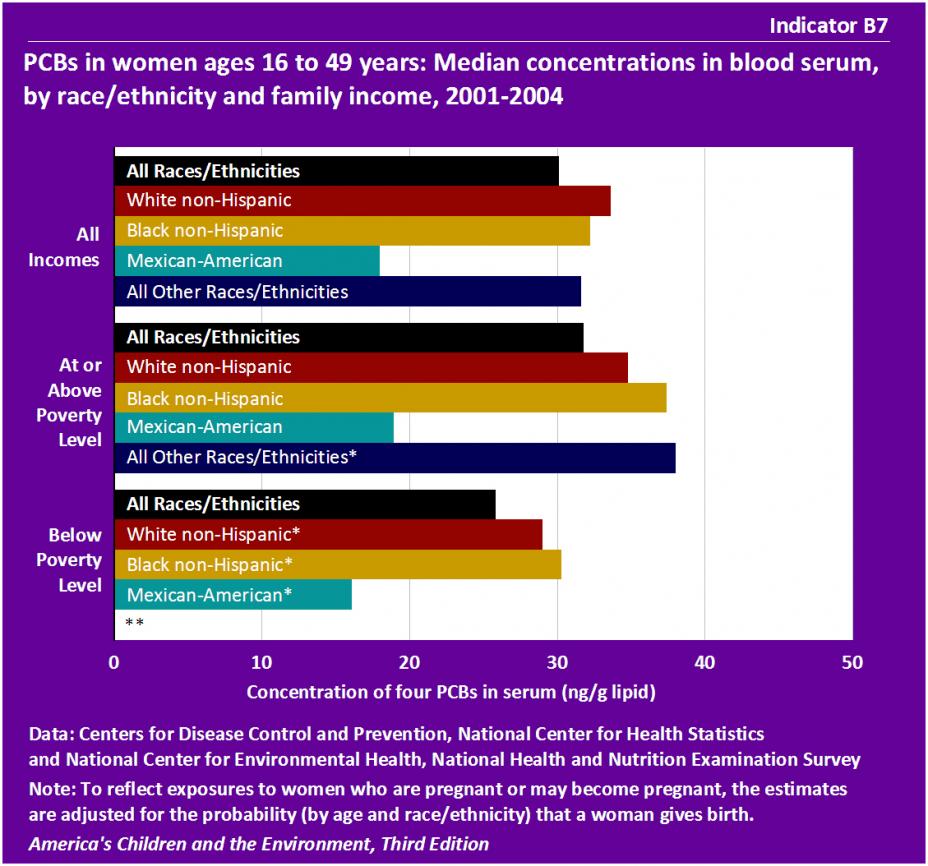ACE: Biomonitoring - Polychlorinated Biphenyls (PCBs)
- Indicator B7 – PCBs in women ages 16 to 49 years: Median concentrations in blood serum, by race/ethnicity and family income, 2001-2004
- Background Text
- Methods
Indicator B7
 *The estimate should be interpreted with caution because the standard error of the estimate is relatively large: the relative standard error, RSE, is at least 30% but is less than 40% (RSE = standard error divided by the estimate), or the RSE may be underestimated.
*The estimate should be interpreted with caution because the standard error of the estimate is relatively large: the relative standard error, RSE, is at least 30% but is less than 40% (RSE = standard error divided by the estimate), or the RSE may be underestimated.
** The estimate is not reported because it has large uncertainty: the relative standard error, RSE, is 40% or greater (RSE = standard error divided by the estimate), or the RSE cannot be reliably estimated.
Data characterization
- Data for this indicator are obtained from an ongoing continuous survey conducted by the National Center for Health Statistics.
- Survey data are representative of the U.S. civilian noninstitutionalized population.
- PCBs are measured in blood samples obtained from individual survey participants.
- In 2001-2004, the median level of PCBs in blood serum among women ages 16 to 49 years (the sum of PCBs 118, 138, 153 and 180) was 30 ng/g lipid.
- Median PCB levels were higher for women with higher incomes than for women with lower incomes, consistently for all race/ethnicity groups.
- After accounting for other demographic differences (i.e., differences in age profile), the differences between income levels for each race/ethnicity group were not statistically significant except for the differences for White non-Hispanic women.
- Median PCB levels were lower among Mexican-American women than among women of any other race/ethnicity group.
- These differences were statistically significant. After accounting for other demographic differences (i.e., differences in income or age profile), the differences remained statistically significant except for that between Mexican-American women and women of “All Other Races/Ethnicities.”
- The 95th percentile concentration of PCBs among women ages 16 to 49 years was 106 ng/g lipid. Among women of “All Other Races/Ethnicities,” the 95th percentile PCB concentration was substantially higher, at 245 ng/g lipid; the 95th percentile concentration among Mexican-American women was substantially lower at 49 ng/g lipid. (See Table B7a.)
- These differences were statistically significant: the 95th percentile for women of “All Other Races/Ethnicities” was greater than the value for each of the remaining race/ethnicities; and the 95th percentile for Mexican-American women was less than the value for each of the remaining race/ethnicities.
Background Text
About the PCBs Indicator
Indicator B7 presents information about polychlorinated biphenyl (PCB) levels measured in women. The data are from a national survey that collects blood specimens from a representative sample of the population every two years, and then measures the concentration of various contaminants in the blood. The indicator focuses on women of child-bearing age because of concern for potential adverse effects in children born to women who have been exposed to PCBs.
- Indicator B7 presents concentrations of PCBs in blood serum of women ages 16 to 49 years, by race/ethnicity and level of family income, in 2001-2004.
PCBs are a family of industrial chemicals that were produced in the United States from 1929 to 1979 and used primarily as insulating fluids in capacitors, transformers, and other electrical equipment. PCBs were also used as plasticizers in many paints, plastics, and rubber products, and had numerous applications in industry and building construction. They remain widely distributed in the environment due to their persistent nature. PCBs are present in fish, meat, poultry, dairy products, and breast milk, so dietary intake is an important pathway of exposure. Breast-feeding infants are exposed to PCBs in the milk of mothers with previous exposure. PCBs can also transfer prenatally from mother to fetus. Recent findings suggest that the presence of PCBs in indoor dust and indoor air may also constitute an important exposure pathway for some portion of the population.
Although there is some inconsistency in the epidemiological literature, several reviews of the literature have concluded that the overall evidence supports a concern for effects of PCBs on children’s neurological development. The Agency for Toxic Substances and Disease Registry (ATSDR) has determined that “substantial data suggest that PCBs play a role in neurobehavioral alterations observed in newborns and young children of women with PCB burdens near background levels.”
Indicator B7 presents PCB levels measured in blood serum of women from the National Health and Nutrition Examination Survey (NHANES).
More information about PCBs and Indicator B7 is provided in the PCB section of America's Children and the Environment, Third Edition.
Related Links
National Toxicology Program (NTP): Report on Carcinogens, Polychlorinated Biphenyls
U.S. EPA: Polychlorinated Biphenyls (PCBs)
U.S. EPA: Healthy School Environment Resources, PCBs
U.S. EPA: Hudson River PCBs Superfund Site
Methods
Summary of Methods - PCBs
The National Center for Health Statistics, a division of the Centers for Disease Control and Prevention, conducts the National Health and Nutrition Examination Surveys (NHANES), a series of U.S. national surveys of the health and nutrition status of the noninstitutionalized civilian population. Interviews and physical examinations are conducted with approximately 10,000 people in each two-year survey cycle. The survey measures PCB levels in blood serum samples collected from NHANES participants.
Indicator B7 uses the NHANES data to present median concentrations of PCBs, computed as the sum of PCBs 118, 138, 153, and 180, measured in blood serum of women ages 16 to 49 years, stratified by race/ethnicity and level of family income.
Detailed Methods for Indicator B7
Metadata for National Health and Nutrition Examination Surveys (NHANES)